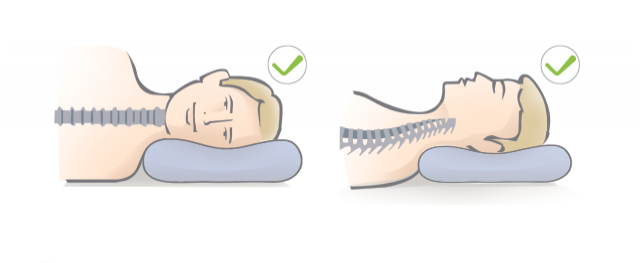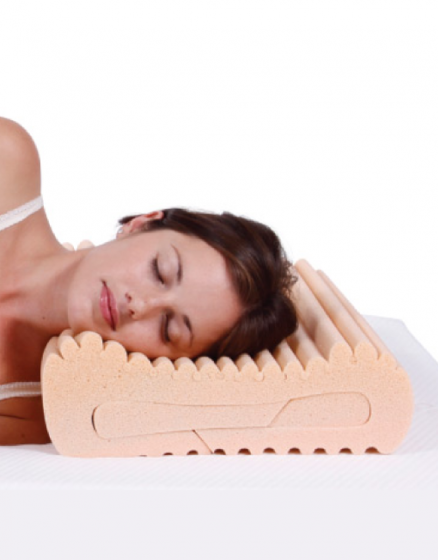Published on Tuesday, 15 November 2022 at 10:04:12 AM
One of the most common questions we get asked here in the clinic, is what is the right pillow for me? This blog aims to answer all your questions on this really important issue and hopefully results in you attaining a stronger, better supported neck and getting a great night’s sleep.
“JUST BECAUSE YOUR PILLOW IS COMFORTABLE, DOESN’T MEAN IT’S THE RIGHT ONE FOR YOU!”
Neck pain is a very common and increasing complaint in society. Many people are bothered by pain during the night, having to frequently change positions whilst in bed, due to discomfort. Alternatively, they wake up with neck pain in the mornings. As we will explain later, your pillow isn’t necessarily causing this entirely, but may well not be helping matters, if it’s the wrong one for you.
Neck pain, disappointingly, is on the rise due a variety of factors, with static and rounded work and lifestyle postures being a massive contributor. Put simply, the human spine is designed to spend most of the time in a tall posture and moving freely through all of its natural ranges of motion, symmetrically and consistently throughout the day. Sadly, our current desk based, tech obsessed lifestyles mean that in many cases, our spines are operating within a very limited, one side dominant range of motion and our joints spend far too much time still. This results in poor muscle control of the joints, increased joint loading, poor joint alignment and eventually pain.

Too many people think that if they have neck pain, there is something wrong with their pillow! In fact, they are expecting too much of their pillow and actually, the first thing that needs to be done, is that they need to get their spine functioning at a higher level. This can be achieved with in office treatment, home exercise and lifestyle and ergonomic advice. Once you’ve sorted out any spinal dysfunction, then it’s time to find the right pillow to support the joints of the neck!
What pillow is right for you?
There are several factors that need to be considered when choosing your pillow, but the two main ones are preferred sleep posture and preferred level of pillow firmness.
Put simply, people who prefer to sleep on their back require a thinner pillow than those who sleep on their side. People who sleep on their stomach only require a very thin pillow, although this position is not recommended as a general rule, due to strain on the spine.
Essentially, the ideal pillow height all comes down to which height keeps your neck in a ‘neutral’ position when you are in your preferred sleep position. Of course, some people begin in one position and wake up in another, so it is important to work out which position you spend most of your time in and get a pillow to match that.
A great way to find out if your current pillow is supporting you in a neutral posture is to lay in your preferred position and have someone stand side on (for back sleepers) or from behind (for side sleepers) and assess if your neck is neutral or not. A second person is required because what may feel like a neutral position to you, is often not a neutral position when properly assessed.
In clinic we often hear people say that they have bought countless pillows over the years and nothing seems to suit them. In these cases, a vast majority of people have never properly addressed their underlying spinal dysfunction, nor have had their pillows properly sized.
"If you think a soft, thin pillow that you squash under your neck is helping you…. you are probably wrong!"
What does a neutral position look like?

A neutral position essentially is one where the plane of the face is horizontal. This applies to both side and back sleepers. Many people unwittingly sleep on their back with their chin tucked towards their chest (in the case of a oversized pillow) or sleep on their sides with their neck tilting down towards to mattress (in the case of an undersized pillow.)
It’s worth remembering that factors like how firm your mattress is will determine how far in the shoulders of side sleepers sink in and hence the height of the pillow required to maintain a neutral posture. For this reason, in many cases, when people buy a new mattress, they require a new pillow too.
Firmness is also a very important factor to thinking about when choosing your new pillow. Your individual preference for firmness is very important, as you need to feel comfortable and be in good alignment. Most pillow ranges come in soft, medium and firm densities, so it is just a matter of trying them out to see what you are happy with.
How long should I keep my pillow before changing it out?
We must consider two important factors here, pillow structural integrity and hygiene!
From a structural integrity perspective, the firmer the pillow, the longer they tend to last. Also, the pillow composition plays a big role. For example, memory foam and latex pillows tend to last longer than standard foam or down pillows.
From a hygiene perspective, pillow manufacturers often advise customers to replace their pillows every 1-2 years due to a build-up of dead skin, hair cells and mites. Not a pleasant thought!!
Why do we recommend contour pillows?
Unlike regular pillows, contour pillows provide far better support of the neck for both side and back sleepers as they allow the head to lie in the hollow, with the ridge supporting the neck.

Geraldton Health Centre stocks a wide range of high-quality pillows across the price spectrum and to suit all different shapes, sizes and sleep positions. Our Physiotherapists, Chiropractors, Soft Tissue Therapists and front desk team are all trained on pillow specifications and are happy to provide advice and fitting to make sure your pillow is the right one for you.

Importantly, many people find that it takes 2-3 weeks to get used to their new pillow because their neck is being supported in an unfamiliar way. In most cases, patients are still able to sleep through the night on the new pillow, but in some circumstances, we advise patients to use the pillow until they become uncomfortable and then change back to their old pillow. Gradually, patients find that they are able to use their new pillow for longer and longer periods and eventually use it all night.
For any additional information regarding pillows or neck pain more generally, please simply contact our wonderful front desk team via phone or email.
Back to All News